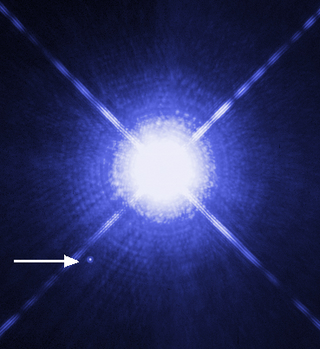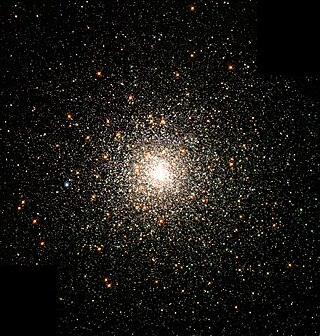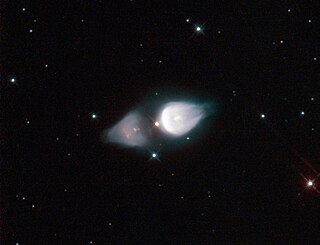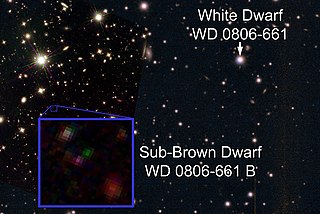Related Research Articles

A star is a luminous spheroid of plasma held together by self-gravity. The nearest star to Earth is the Sun. Many other stars are visible to the naked eye at night; their immense distances from Earth make them appear as fixed points of light. The most prominent stars have been categorised into constellations and asterisms, and many of the brightest stars have proper names. Astronomers have assembled star catalogues that identify the known stars and provide standardized stellar designations. The observable universe contains an estimated 1022 to 1024 stars. Only about 4,000 of these stars are visible to the naked eye—all within the Milky Way galaxy.

In astronomy, stellar classification is the classification of stars based on their spectral characteristics. Electromagnetic radiation from the star is analyzed by splitting it with a prism or diffraction grating into a spectrum exhibiting the rainbow of colors interspersed with spectral lines. Each line indicates a particular chemical element or molecule, with the line strength indicating the abundance of that element. The strengths of the different spectral lines vary mainly due to the temperature of the photosphere, although in some cases there are true abundance differences. The spectral class of a star is a short code primarily summarizing the ionization state, giving an objective measure of the photosphere's temperature.

A white dwarf is a stellar core remnant composed mostly of electron-degenerate matter. A white dwarf is very dense: its mass is comparable to the Sun's, while its volume is comparable to Earth's. A white dwarf's low luminosity comes from the emission of residual thermal energy; no fusion takes place in a white dwarf. The nearest known white dwarf is Sirius B, at 8.6 light years, the smaller component of the Sirius binary star. There are currently thought to be eight white dwarfs among the hundred star systems nearest the Sun. The unusual faintness of white dwarfs was first recognized in 1910. The name white dwarf was coined by Willem Luyten in 1922.

In astronomy, metallicity is the abundance of elements present in an object that are heavier than hydrogen and helium. Most of the normal currently detectable matter in the universe is either hydrogen or helium, and astronomers use the word "metals" as convenient shorthand for "all elements except hydrogen and helium". This word-use is distinct from the conventional chemical or physical definition of a metal as an electrically conducting solid. Stars and nebulae with relatively high abundances of heavier elements are called "metal-rich" in astrophysical terms, even though many of those elements are nonmetals in chemistry.

M1-92, also known as Minkowski’s Footprint or the Footprint Nebula, is a bipolar protoplanetary nebula in the constellation of Cygnus. It is a type of reflection nebula, visible only by light reflected from the central star. The central star is not yet a white dwarf but is quickly becoming one. In a few thousand years the star will be hot enough to emit vast quantities of ultraviolet radiation that will ionize the nebula surrounding it, making it a fully fledged planetary nebula.
Doris Daou is a Lebanese-born Canadian-American astronomer who was formerly the Director for Education and Public Outreach of the NASA Lunar Science Institute and the associate director of the NASA Solar System Exploration Research Virtual Institute (SSERVI), and is currently the program contact for NASA's "Small Innovative Missions for Planetary Exploration (SIMPLEx)".
Rebecca Oppenheimer is an American astrophysicist and one of four curator/professors in the Department of Astrophysics at the American Museum of Natural History (AMNH) on Manhattan's Upper West Side. Oppenheimer is a comparative exoplanetary scientist. She investigates planets orbiting stars other than the Sun. Her optics laboratory is the birthplace of a number of new astronomical instruments designed to tackle the problem of directly seeing and taking spectra of nearby solar systems with exoplanets and studying their composition, with the ultimate goal of finding life outside the solar system.

Nicholas B. Suntzeff is an American astronomer and cosmologist. He is a University Distinguished Professor and holds the Mitchell/Heep/Munnerlyn Chair of Observational Astronomy in the Department of Physics & Astronomy at Texas A&M University where he is Director of the Astronomy Program. He is an observational astronomer specializing in cosmology, supernovae, stellar populations, and astronomical instrumentation. With Brian Schmidt he founded the High-z Supernova Search Team, which was honored with the Nobel Prize in Physics in 2011 to Schmidt and Adam Riess.

RX Andromedae is a variable star in the constellation of Andromeda. Although it is classified as a dwarf nova of the Z Camelopardalis (UGZ) type, it has shown low-luminosity periods typical of VY Sculptoris stars. However, for most of the time it varies from an apparent visual magnitude of 15.1 at minimum brightness to a magnitude of 10.2 at maximum brightness, with a period of approximately 13 days.

WD 0806−661, formally named Maru, is a DQ white dwarf with an extremely cold Y-type substellar companion, located in the constellation Volans at 62.7 light-years from Earth. The companion was discovered in 2011, and is the only known Y-type companion to a star or stellar remnant. At the time of its discovery WD 0806-661 B had the largest actual and apparent separation of any known planetary-mass object, as well as being the coldest directly imaged substellar object then known.

Debra Meloy Elmegreen is an American astronomer. She was the first woman to graduate from Princeton University with a degree in astrophysics, and she was the first female post-doctoral researcher at the Carnegie Observatories.

Laura Ferrarese is a researcher in space science at the National Research Council of Canada. Her primary work has been performed using data from the Hubble Space Telescope and the Canada-France-Hawaii Telescope.

SU Ursae Majoris, or SU UMa, is a close binary star in the northern circumpolar constellation of Ursa Major. It is a periodic cataclysmic variable that varies in magnitude from a peak of 10.8 down to a base of 14.96. The distance to this system, as determined from its annual parallax shift of 4.53 mas, is 719 light-years. It is moving further from the Earth with a heliocentric radial velocity of +27 km/s.

Kevin France is an astrophysicist and assistant professor in the Department of Astrophysical and Planetary Sciences at the University of Colorado. His research focuses on exoplanets and their host stars, protoplanetary disks, and the development of instrumentation for space-borne astronomy missions.
Jean L. Turner is an astrophysicist and distinguished professor in the Department of Physics and Astronomy at the University of California, Los Angeles. She was lead author on research and discovery of a particular star cluster in the dwarf galaxy NGC 5253, considered 'remarkable' for being an extremely dusty gas cloud and having highly efficient star formation.

BZ Ursae Majoris is a dwarf nova star system in the northern circumpolar constellation of Ursa Major. It consists of a white dwarf primary in a close orbit with a red dwarf. The latter star is donating mass, which is accumulating in an accretion disk orbiting the white dwarf. The system is located at a distance of approximately 505 light years from the Sun based on parallax measurements.
You-Hua Chu is a Taiwanese astronomer. She has served as the director of the Institute of Astronomy and Astrophysics, Academia Sinica and the chair of the Department of Astronomy at the University of Illinois at Urbana-Champaign. Her main research areas are interactions between the interstellar medium and stars and observations of planetary systems in the post main sequence stages.

Ata Sarajedini is an astrophysicist, professional astronomer, academic, author, and podcaster. He is the Bjorn Lamborn Endowed Chair and Professor in Astrophysics at Florida Atlantic University.
References
- ↑ Dorminey, Bruce (29 January 2014). "Nearest Dying White Dwarfs Likely Still Harbor Planets". Forbes . Retrieved 7 November 2016.
- 1 2 3 4 "Académie Des Sciences Du Liban". asduliban.org. Retrieved 2016-11-07.
- 1 2 "Edward M. Sion - Associate Member (2010) | Department of Physics and Astronomy". physics.ku.edu. 2014-01-10. Retrieved 2016-11-07.
- ↑ "Edward M. Sion". www.astronomy.villanova.edu. Retrieved 2016-11-07.
- ↑ McCook, George P.; Sion, Edward M. (1984). A Catalogue of Spectroscopically Identified White Dwarfs. Villanova Press.
- ↑ McCook, George. "White Dwarf Catalog". www.astronomy.villanova.edu. Retrieved 2016-11-07.
- ↑ Sion, E. M.; Greenstein, J. L.; Landstreet, J. D.; Liebert, James; Shipman, H. L.; Wegner, G. A. (1983). "A proposed new white dwarf spectral classification system". The Astrophysical Journal. 269: 253. Bibcode:1983ApJ...269..253S. doi: 10.1086/161036 .
- ↑ Corbally, Christopher J.; Gray, Richard O.; Burgasse, Adam J. (2009). Stellar Spectral Classification. Princeton University Press. ISBN 9780691125114.
- ↑ Sion, Edward M. (15 July 1984). "Implications of the absolute magnitude distribution functions of DA and non-DA white dwarfs". Astrophysical Journal. 282: 612–614. Bibcode:1984ApJ...282..612S. doi:10.1086/162240.
- ↑ "HubbleSite - NewsCenter - Hubble Probes the Workings of a Stellar Hydrogen Bomb (05/22/1995) - Release Text". hubblesite.org. Retrieved 2016-11-07.
- ↑ "IOPscience - search results". iopscience.iop.org. Retrieved 2016-11-19.
- ↑ "Astronomy & Astrophysics (A&A)". www.aanda.org. Retrieved 2016-11-19.
- ↑ "JSTOR: Search Results". www.jstor.org. Retrieved 2016-11-19.
- ↑ "Searching journal content for sion, e in author". Oxford Journals. Oxford University Press.[ dead link ]
- ↑ "Edward Sion". Big Think. 2010-03-08. Retrieved 2016-11-19.
- ↑ Dorminey, Bruce (30 June 2014). "Odds Against Earth Being Hit By Lethal Supernova". Forbes .
- ↑ "The Outstanding Faculty Research Award". www1.villanova.edu. Retrieved 2016-11-07.
- ↑ "International Astronomical Union | IAU". www.iau.org. Retrieved 2016-11-07.
- ↑ "The Outstanding Faculty Mentor Teaching Award | Villanova University". www1.villanova.edu. Retrieved 2024-04-16.
- ↑ kelinich (2014-02-22). "Committee on Science & the Arts | The Franklin Institute". fi.edu. Retrieved 2024-04-16.